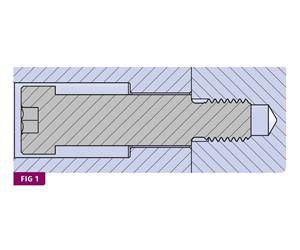Safety Sense in the Shop
Running a clean, organized, professional, and safe shop requires a team effort that includes an awareness of unsafe practices and equipment that need to be eliminated, replaced, or improved, along with the accountability of all to identify and document safety issues.
Punch “dangerous jobs” into Google and you will see some statistics that may interest you. Fishermen, farmers, and miners are among the jobs that cause the highest numbers of injuries, illnesses, and deaths that are tracked by several government agencies and insurance firms.
Plastics manufacturing is not without its own dangers. As a matter of fact, according to the Bureau of Labor Statistics, it is one area of industrial manufacturing that increased in the number of accidents in 2010 while the rest of that sector saw a gradual decline as more companies focus on being “safety conscious.” Not a bad idea, because the Liberty Mutual Workplace Safety Index says workplace injuries cost companies more than $1 billion a week in direct workers compensation payouts.
So why is plastics manufacturing suffering a higher than average accident rate? Many factors need to be considered. A major aspect is the type of work required to produce plastic parts. In the typical plastics and rubber plant, there is no shortage of dangerous (and many times old) machinery, as well job descriptions that require lifting, moving, and working with heavy molds.
Disabling injuries are tracked under ominous categories like “caught/compressed, amputations, lacerations, chemical burns,” etc., along with other information that paints a pretty clear picture of who gets hurt, how, and when.
I put together a snapshot of the person most likely to get injured on the job based on stats from the Bureau of Labor Statistics. The figuress for 2010 say that if you work in plastics manufacturing you stand the best chance to get hurt on the job if you are a 45- to 54- year-old white male. You work in production, where you have been for five years or more. You will suffer a sprain or strain in the upper extremities of your body (arms, hands, neck, chest—not back or shoulders) as a result of overexertion. You will have been injured on a Monday morning after two to four hours of work. And you were off work for more than 31 days due to your injury (the overall average time off was 7 days).
An interesting statistic is that this injured person was on average a 5-year employee—not a “newbie”—and the logic makes sense, especially in the tool room.
Repair technicians work with their hands on a day-to-day basis, using potentially dangerous hand tools and machinery on tooling and components with sharp edges. It gets easy to become oblivious or “overly comfortable” with potentially hazardous conditions and shop practices that are sometimes “grandfathered” into the environment in which they work.
Another factor that can’t be overlooked is the effect of the economic crash of recent years on reducing head counts that were formerly utilized when performing the above-mentioned duties. Today, the number of repair technicians in most companies is just barely adequate to get molds out the door. The “fat” days of having an abundance of resources to “pitch in” to quickly handle unscheduled mold stops or other critical tasks are long behind us as companies look to streamline and do more with less.
So today, as business begins to pick up, companies are reluctant to rehire technicians, choosing instead to try to maintain head counts and promote a leaner operational strategy. This translates into employees doing more and working faster and possibly in an area where they are not properly experienced or trained in safe techniques and practices. With cross-training of plastics job skills (setting, running, pulling, and repairing) becoming the norm, it just makes sense that so should safety training in areas where correct procedures may be lacking and accidents are bound to happen.
Here are 20 areas of potential danger—divided into two groups—that should be considered when working on molds and components:
Unsafe Shop Environment Factors
•No adequate overhead hoist above benches.
•Poor mold-moving equipment, practices, and training.
•Dimly lit bench work area.
•Greasy, grimy (slippery) floors and poor housekeeping practices.
•Tripping hazards like air/hydraulic/water hoses and electrical cords on the floor.
•Poor general shop layout with benches inadequate in size and number and too close together to work safely among them.
•No designated, clearly marked, and monitored aisles or walkways.
•Molds in transition stored or scattered randomly around the shop, close to traffic areas.
•General disorganization and lack of proper maintenance and care with community tools.
•Lack of a formal safety program where employees are responsible for creating safe, specific repair practices that promote teamwork and job awareness that keep “mold and man” safe and efficient.
Typical Unsafe Repair/Bench Practices
•Splitting molds incorrectly (this requires proper pry-bar techniques and/or the proper equipment).
•Not using “feet” or braces to support standing plates (getting too much in a hurry).
•Sliding mold plates around on rails (potential for the dreaded “domino” smash and crash).
•Using cleaning solvents and equipment unsafely (respiratory, eye, and burn issues).
•Not using mold straps.
•Using incorrect eyebolts/methods for laying molds over/flipping .
•Not having the right tools—or using them incorrectly.
•Using cheap tools.
•Not working as a team and sharing maintenance knowledge.
•Working carelessly, too quickly, or uninformed and not thinking the job through. (If this wrench that I am leaning on with all my might slips or breaks—what will my hand slam into?)
These are only a glimpse of the issues that can cause injury in a mold-repair environment. Working safely with hand tools is all about using the right tool to overcoming resistance (installing, tightening, loosening, and removing). Skilled tradesmen have the ability to “read” and judge the correct amount of pressure needed before something slips or breaks, and they have the discipline to stop and rethink the procedure before taking unnecessary chances just to save a few minutes.
Running a clean, organized, professional, and safe shop requires a team effort that includes an awareness of unsafe practices and equipment that need to be eliminated, replaced, or improved, along with the accountability of all to identify and document safety issues. And then it takes action. Make 2012 the year you finally create and practice common safety sense. I promise it won’t hurt.
Related Content
Why Shoulder Bolts Are Too Important to Ignore (Part 2)
Follow these tips and tricks for a better design.
Read MoreHow to Start a Hot-Runner Mold That Has No Tip Insulators
Here's a method to assist with efficient dark-to-light color changes on hot-runner systems that are hot-tipped.
Read MoreHow To Design Three-Plate Molds – Part 4
There are many things to consider, and paying attention to the details can help avoid machine downtime and higher maintenance costs — and keep the customer happy.
Read MoreHow to Design Three-Plate Molds, Part 1
There are many things to consider, and paying attention to the details can help avoid machine downtime and higher maintenance costs, and keep the customer happy.
Read MoreRead Next
See Recyclers Close the Loop on Trade Show Production Scrap at NPE2024
A collaboration between show organizer PLASTICS, recycler CPR and size reduction experts WEIMA and Conair recovered and recycled all production scrap at NPE2024.
Read MoreBeyond Prototypes: 8 Ways the Plastics Industry Is Using 3D Printing
Plastics processors are finding applications for 3D printing around the plant and across the supply chain. Here are 8 examples to look for at NPE2024.
Read MorePeople 4.0 – How to Get Buy-In from Your Staff for Industry 4.0 Systems
Implementing a production monitoring system as the foundation of a ‘smart factory’ is about integrating people with new technology as much as it is about integrating machines and computers. Here are tips from a company that has gone through the process.
Read More














